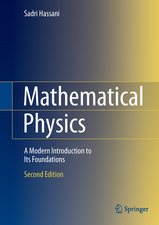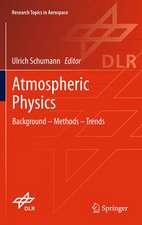Das Sternsystem: Erster Teil
Autor Heber D. Curtis, B. Lindblad, K. Lundmark, H. Shapley Editat de G. Eberhard, A. Kohlschüüter, H. Ludendorffde Limba Germană Paperback – 31 dec 1932
Preț: 517.91 lei
Preț vechi: 609.30 lei
-15% Nou
Puncte Express: 777
Preț estimativ în valută:
99.11€ • 105.97$ • 82.63£
99.11€ • 105.97$ • 82.63£
Carte tipărită la comandă
Livrare economică 18 aprilie-02 mai
Preluare comenzi: 021 569.72.76
Specificații
ISBN-13: 9783642888496
ISBN-10: 3642888496
Pagini: 596
Ilustrații: X, 1156 S. 53 Abb.
Dimensiuni: 170 x 244 x 31 mm
Greutate: 0.93 kg
Ediția:Softcover reprint of the original 1st ed. 1933
Editura: Springer Berlin, Heidelberg
Colecția Springer
Locul publicării:Berlin, Heidelberg, Germany
ISBN-10: 3642888496
Pagini: 596
Ilustrații: X, 1156 S. 53 Abb.
Dimensiuni: 170 x 244 x 31 mm
Greutate: 0.93 kg
Ediția:Softcover reprint of the original 1st ed. 1933
Editura: Springer Berlin, Heidelberg
Colecția Springer
Locul publicării:Berlin, Heidelberg, Germany
Public țintă
ResearchDescriere
Dieser Buchtitel ist Teil des Digitalisierungsprojekts Springer Book Archives mit Publikationen, die seit den Anfängen des Verlags von 1842 erschienen sind. Der Verlag stellt mit diesem Archiv Quellen für die historische wie auch die disziplingeschichtliche Forschung zur Verfügung, die jeweils im historischen Kontext betrachtet werden müssen. Dieser Titel erschien in der Zeit vor 1945 und wird daher in seiner zeittypischen politisch-ideologischen Ausrichtung vom Verlag nicht beworben.
Cuprins
4. Luminosities, Colours, Diameters, Densities, Masses of the Stars.- d) The Diameters of the Stars.- 190. The Diameters of the Stars. Earlier Conceptions. Pioneer Work.- 191. Wilsing’s Investigations.- 192. Russell’s Method.- 193. Diameters from c2/T.- 194. Diameters from Radiometric Measurements.- 195. Kalmár’s Investigation.- 196. Interferometer Measurements at Mount Wilson.- 197. Varying Stellar Diameters.- 198. The Theoretical Investigations of M. Hamy.- 199. Danjon’s Interferometer-Method.- 200. The Companion of Sirius (Sirius B).- 201. Diameters from Scintillation-Observations.- 202. The Fallacy in S. Pokrowsky’s Method.- e) The Densities of the Stars.- 203. Densities of the Stars. Pioneer Work.- 204. Densities of Visual Binary Stars.- 205. The Ratio of Densities in Double Stars.- 206. Densities of Eclipsing Binaries. Methodical.- 207. Shapley’s Work.- 208. Parallaxes and Absolute Magnitudes of Eclipsing Binaries.- 209. Recent Statistics of the Eclipsing Binaries.- f) The Masses of the Stars.- 210 Methods of Deriving Stellar Masses.- 211. Are Derived Mass-Values Representative?.- 212. Historical Notes. Observational Evidences.- 213. Equipartition of Stellar Energy.- 214. Schlesinger’s and Baker’s Study on Spectroscopic Binaries.- 215. Ludendorff’s Researches on the Masses of Spectroscopic Binaries.- 216. Frequency of Stellar Masses for Different Spectral Classes.- 217. Sproul Determinations of Masses.- 218. Pitman’s Investigation.- 219. Statistics of accurately Determined Stellar Masses.- 220. Real and Apparent Masses.- 221. Seares’s Researches.- 222. Stellar Masses from Spectrographic Parallaxes.- 223. Masses of F—K Stars.- 224. Colour-Mass-Density Relation.- 225. von Zeipel’s Method.- 226. The Method of Freundlich and Heiskanen.- 227. Martens’s Method.- 228. Recent Work Concerning Masses of Spectroscopic Binaries.- 229. Preferential Values of Stellar Masses.- 230. Dwarf Nature of Spectroscopic Binaries.- 231. Discovery of Mass-Luminosity Relation.- 232. Eddington’s Mass-Luminosity Law and Cosmogonie Time-Scale.- 233. Discrepancies between Seares’s and Eddington’s Results.- 234. Jeans’s Theory.- 235. The Cosmogonic Time-Scale by Jeans and Smart.- 236. Brill’s Theory and Parallax-Method for Binaries.- 237. Mass-Reduction by Annihilation of Protons and Electrons.- 238. The Theory of Rabe.- 239. Convergence of Mass-Ratios with Increasing Age.- 240. Vogt’s Extension of Eddington’s Theory.- 241. Statistical Investigations Concerning the Mass-Ratio in Binaries.- 242. Theoretical Derivation of the Mass-Ratio in Double Stars.- 243. Lundmark’s and Luyten’s Differential Method.- 244. The Masses and Luminosities of the Eclipsing Binaries.- 245. The Upper Limit for the Stellar Masses.- 246. Relation between Stellar Mass and Proper Motion.- 247. Relation between Stellar Mass and Form of Orbits of Binary Stars.- 248. The Mass of the Orion Nebula.- 249. Planetary Nebulae.- 250. Mass of the Stellar System.- 251. The Masses and Mass-Ratios of Stellar Systems.- 252. The Angular Moments of Visual Binaries.- 253. The Origin of Binary Stars.- 254. Concluding Remarks.- Appendix I. Catalogue of Stars Brighter than 5m,00.- Appendix II. Catalogue of Stellar Diameters.- 5. Stellar Clusters.- a) Introductory Survey.- 1. The Significance of Clusters.- 2. Historical Notes on Clusters.- b) Classification, Number and Distribution.- 3. A Comparison of Galactic and Globular Clusters.- 4. The Number of Clusters.- 5. Classification of Galactic Clusters.- 6. Classification of Globular Clusters.- 7. Clusters in or near Obstructing Nebulosity.- 8. The Apparent Distribution of Globular Clusters.- 9. The Apparent Distribution of Galactic Clusters.- 10. Peculiarities in the Distribution of Galactic Clusters.- c) On the Spectral Composition of Clusters.- 11. Integrated Spectra of Globular Clusters.- 12. Stellar Types in Globular Clusters.- 13. On the Masses of Giant Stars.- 14. Spectra in Individual Galactic Clusters.- d) Variable Stars in Star Clusters.- 15. The Frequency and General Properties of Variable Stars in Clusters.- 16. A Summary of Known Variables.- e) The Distribution of Stars in Globular Clusters.- 17. Are Cluster Stars Arranged Spirally?.- 18. On the Laws of Distribution.- 19. Luminosity Curves for Stars in Clusters.- f) The Forms of Clusters.- 20. Definition and Difficulties.- 21. The Elongation of Messier 13.- 22. Ellipticity and Orientation of Globular Clusters.- 23. Some Peculiar Clusters.- 24. The Structure of Galactic Clusters.- g) The Transparency of Space.- 25. Early Investigations of Light Scattering.- 26. Blue Stars in Messier 13.- 27. Faint Blue Stars in the Milky Way.- 28. Colors in Other Distant Objects.- 29. Messier 5 and the Relative Speeds of Blue and Yellow Light.- h) The Distances and Dimensions of Clusters.- 30. The Photographic Period-Luminosity Curve.- 31. Distances of Globular Clusters Obtained from Cepheids and Bright Stars.- 32. Distances of Globular Clusters Obtained from Diameters and Integrated Magnitudes.- 33. A Working Catalogue of Galactic Clusters (Appendix B).- 34. Parallaxes of Galactic Clusters.- 35. Radial Velocities of Globular Clusters.- 36. Dimensions and Star Densities of Clusters.- i) Star Clusters in the Magellanic Clouds.- 37. Types of Clusters and Nebulae.- 38. The Globular Star Clusters.- 39. Distances of the Clouds.- 40. On the Relation of the Clusters to the Magellanic Clouds.- j) Dimensions of the Galaxy.- 41. Membership in the Galaxy.- 42. The System of Galactic Clusters.- 43. The Higher Systems of Globular Clusters.- 44. The Distance to the Galactic Center.- 45. On the Size and Structure of the Galaxy.- Appendix A. Catalogue of Globular Clusters.- Appendix B. Catalogue of Galactic Clusters.- 6. The Nebulae.- a) Introduction.- 1. Definition of Nebulae.- 2. Historical Notes.- 3. Bibliographical Notes.- 4. Classification and Units.- b) The Diffuse Nebulae.- 5. Definition.- 6. Number and Distribution.- 7. Physical Characteristics of Diffuse Nebulae.- 8. Dark. Nebulae.- 9. Cosmic Clouds.- 10. Distances and Dimensions of Diffuse Nebulae.- 11. Luminous Diffuse Nebulae.- 12. Proper Motions and Internal Motions (Visual).- 13. Radial Velocities of Diffuse Nebulae.- 14. Turbulence Effects in Diffuse Nebulae.- 15. Luminosity of the Diffuse Nebulae: Gaseous Spectra.- 16. Emission Variations.- 17. Luminosity of the Diffuse Nebulae: Reflection or Resonance Effects.- 18. Variable Diffuse Nebulae.- 19. Evolutionary Status of the Diffuse Nebulae.- c) The Planetary Nebulae.- 20. Definition of the Planetary Type.- 21. Number and Distribution of the Planetaries.- 22. Forms Assumed by the Planetary Nebulae.- 23. Proper Motions of the Planetary Nebulae.- 24. Distances and Dimensions of the Planetary Nebulae.- 25. Planetary Spectra; Spectrum of the Nebulous Matter.- 26. Planetary Spectra; Spectrum of Planetary Nuclei.- 27. Radial Velocities of Planetary Nebulae; Rotation.- 28. Spectroscopic Distribution Effects.- 29. Turbulence Effects in the Planetaries.- 30. Mechanical Theories of Planetary Structure.- 31. Quantum Theory and Planetary Structure.- 32. The Theories of Zanstra, Bowen, Carroll and Berman.- 33. Evolutionary Status of the Planetary Nebulae.- d) The Spirals.- 34. Historical Note on the Spirals.- 35. Apparent Distribution of the Spirals; Super-Galaxies.- 36. The Number of the Spirals.- 37. Conspectus of Forms Assumed.- 38. True Spirals.- 39. Barred Spirals.- 40. Elliptical Spirals; the Provenance of the „Minute“ Spirals.- 41. Irregular and Magellanic Type Spirals.- 42. Occulting Matter in the Spirals, and its Bearing on Observed Distribution.- 43. Proper Motions of the Spirals.- 44. The Spirals as a System of Reference.- 45. Internal Motions of the Spirals; Visual Determinations.- 46. Rotation of the Spirals; Spectrographic.- 47. Spectra of the Spirals; Stellar Type.- 48. Spectra of the Spirals; Emission Lines.- 49. Color Indices of the Spirals; the Results of Seares.- 50. The Radial Velocities of the Spirals.- 51. Distances of the Spirals: Parallaxes.- 52. Distances of the Spirals: from Novae.- 53. Distances of the Spirals: from Cepheids.- 54. Distances of the Spirals: from a Distance-Velocity Correlation.- 55. Distances of the Spirals: Photometric; the „Average“ Galaxy.- 56. Distances and Dimensions of the Spirals.- 57. Masses of the Spirals.- 58. Ten Bruggencate’s Theory of Elliptical Spirals.- 59. Theories of Spiral Structure: Introductory.- 60. Agreement of Spiral Arms with Mathematical Spirals.- 61. Wilczynski’s Gravitational Spiral.- 62. Jeans’s Theory of Spiral Structure.- 63. Brown’s Theory of Spiral Structure.- 64. Lindblad’s Theory of Spiral Structure.- 65. Theories of Spiral Structure: Summary.- 66. Evolutionary Status of the Spirals.- 67. Cosmogonical Deductions: Introduction.- 68. The Charlier Infinite Universe.- 69. The Spirals and Relativity Universes: Introduction.- 70 Tolman’s Critique of the de Sitter Relativity Universe.- 71. An Expanding Relativity Universe: the Work of Lemaître, Eddington, McCrea, and McVittie.- 72. The Size of the Universe According to Silberstein.- 73. Various Determinations of the „Radius“ of Space-Time.- 74. Summary: the Dilemma of Choice between an Expanding Relativity Universe and Distance-Velocity Correlation.- 75. Other Cosmogonical Deductions: an Aberration Effect.- 76. Further Considerations on the Apparent Recession of the Spirals.- 77. Earlier Values of the Motion of our Galaxy in Space.- 78. Moëssard’s Modification of the Doppler Formula.- 79. Conclusion.- e) Appendices.- 1. Finding List for Names frequently Used in the Older Literature.- 2. Finding Lists for Sir W. Herschel’s Classes and Numbers.- 3. Finding List for General Catalogue Numbers.- 4. Finding List for Sir J. Herschel’s Numbers.- 5. Systems of Nebular Classification.- 6. Published Reproductions of Nebulae.- 7. Abridged Nebular Bibliographical Apparatus.- 8. A Test of the Moëssard Modification of the Doppler Formula in a Universe of the Charlier Type.- 7. Die Milchstraße.- a) Einleitung.- 1. Die Milchstraße als Objekt der Forschung.- 2. Übersichtliche Darstellungen und Monographien.- b) Das visuelle Milchstraßenbild.- 3. Die Beschreibung und zeichnerische Darstellung der Milchstraße.- 4. Photometrische Eichung der Isophoten.- 5. Die absolute Helligkeit des Himmelsgrundes.- c) Die Photographie der Milchstraße.- 6. Die prinzipiellen Verschiedenheiten der visuellen und photographischen Beobachtungen.- 7. Die photographischen Arbeiten einzelner Forscher.- 8. Milchstraßenzeichnungen auf Grund photographischer Aufnahmen. Photographische Photometrie der Milchstraße.- d) Das allgemeine Bild der Milchstraße nach den visuellen und photographischen Beobachtungen.- 9. Der Verlauf der Milchstraße am Himmel in großen Zügen.- 10. Die Magellanschen Wolken.- 11. Die Lage der Milchstraße.- 12. Galaktische Koordinaten.- e) Der Einfluß der diffusen Nebel auf das Milchstraßenbild.- 13. Die galaktischen Nebelfelder.- 14. Dunkle, wohl markierte Flecke im Sternstratum.- 15. Hagens dunkle Nebel.- f) Die astrophysikalisch-statistischen Ergebnisse über die Natur der Milchstraße.- 16. Die galaktische Konzentration der Sterne und die effektive Sterngröße des Milchstraßenlichtes.- 17. Das Integralspektrum der Milchstraße. Effektive Entfernung der Milchstraßensterne.- 18. Übersicht der allgemeinen statistischen Untersuchungen über die Verteilung der Sterne im Räume.- 19. Die Verteilungsgesetze verschiedener Spektraltypen.- 20. Die galaktische Verteilung spezieller Objekte von großer absoluter Leuchtkraft.- 21. Die Entfernung der Sonne von der Symmetrieebene der Milchstraße.- 22. Spezielle Untersuchungen der Sternleeren und Sternwolken der Milchstraße.- 23. Spezielle Untersuchungen über die Natur der Magellanschen Wolken.- 24. Die Absorption des Lichts im interstellaren Räume.- 25. Die Kalziumwolken in der Milchstraße.- g) Die Dynamik der Milchstraße.- 26. Milchstraße und Gastheorie. Rotation der Milchstraße.- 27. Allgemeine statistische Mechanik des Sternsystems.- 28. Theorie der Sternströmung im typischen Sternsystem.- 29. Einheitliche Theorie des Milchstraßensystems.- 30. Die asymmetrische Geschwindigkeitsverteilung in ihrer Beziehung zur Rotation.- 31. Differentielle Rotationseffekte in den beobachteten Geschwindigkeiten.- 32. Die Beziehung zwischen dem Geschwindigkeitsellipsoid und der Rotation.- 33. Die Dimensionen, die Masse und die Rotationszeit der Milchstraße.- 34. Übersicht verschiedener Anschauungen über die Natur des Milchstraßensystems.










